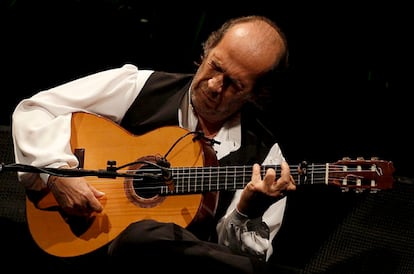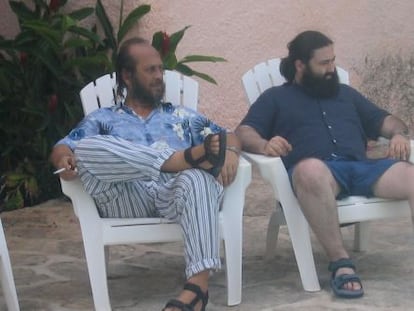Paco de Lucía, guitar virtuoso, dies at 66
Flamenco star who pioneered flamenco-jazz fusion passes away in Mexico Musician was famous for his collaborations with late singer Camarón de la Isla

Paco de Lucía, the brilliant guitarist who pioneered the fusion of flamenco and jazz, has died suddenly of what preliminary reports suggest might be a heart attack. He was 66.
The native of Algeciras (Cádiz) was playing at the beach with his children in the Mexican resort of Cancún, where he owns a home, when he suddenly felt ill, according to his close friend Victoriano Mera. He died on his way to hospital.
The city of Algeciras has decreed three days of mourning and will assist the family in bringing the body home.
De Lucía was a globally admired artist who won the 2004 Prince of Asturias Award for his tireless exploration of the possibilities of flamenco. He will also be remembered for his association with the late flamenco singer Camarón de la Isla during the 1960s and 70s.
The musician had been living in Palma de Mallorca for several years, although he also spent periods in Cuba and the Yucatán peninsula in Mexico. Those who knew him back in Mallorca say he had been less keen about playing the guitar of late. De Lucía preferred to spend time with regular people rather than join intellectual and artistic circles. He also devoted a lot of his time to his two young children.
Born Francisco Sánchez Gómez in 1947, De Lucía, shunned his own legend. Fame came early, in 1975, with his by-now famous rumba Entre dos aguas. It was the last track on the album of the same name that made its way into hundreds of thousands of Spanish homes as society was beginning to shake off the dark dust of the Franco dictatorship.
His association with Camarón alone – the pair released over 10 albums of traditional flamenco together as well as a flamenco-pop-rock fusion record - would have been enough to make De Lucía famous. But there was a lot more to come. His flirtation with jazz earned him accusations of bastardizing flamenco, but he kept on pushing the limits of his music and by the mid-1970s he had formed a sextet that included his two brothers, Pepe de Lucía and Ramón de Algeciras, as well as Jorge Pardo, Carles Benavent and Rubem Dantas. This musical group introduced the Peruvian cajón, a percussion instrument comprising a tall wooden box, into flamenco. Since then, it has become a staple of the genre.
De Lucía also incorporated blues, Indian music, salsa, bossa nova and Arabic music into his own sound. His performances at the Teatro Real opera house in Madrid helped blur the border between high-brow and popular music.
“Everything that can be expressed with the six strings of the guitar is there in his hands,” said the jury that handed him the Prince of Asturias award.
Tu suscripción se está usando en otro dispositivo
¿Quieres añadir otro usuario a tu suscripción?
Si continúas leyendo en este dispositivo, no se podrá leer en el otro.
FlechaTu suscripción se está usando en otro dispositivo y solo puedes acceder a EL PAÍS desde un dispositivo a la vez.
Si quieres compartir tu cuenta, cambia tu suscripción a la modalidad Premium, así podrás añadir otro usuario. Cada uno accederá con su propia cuenta de email, lo que os permitirá personalizar vuestra experiencia en EL PAÍS.
En el caso de no saber quién está usando tu cuenta, te recomendamos cambiar tu contraseña aquí.
Si decides continuar compartiendo tu cuenta, este mensaje se mostrará en tu dispositivo y en el de la otra persona que está usando tu cuenta de forma indefinida, afectando a tu experiencia de lectura. Puedes consultar aquí los términos y condiciones de la suscripción digital.









































